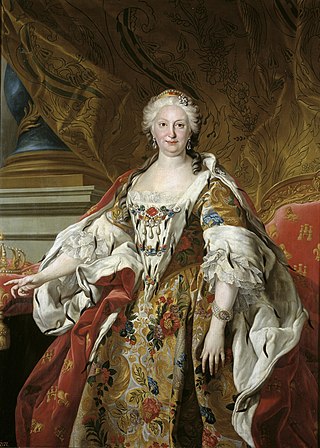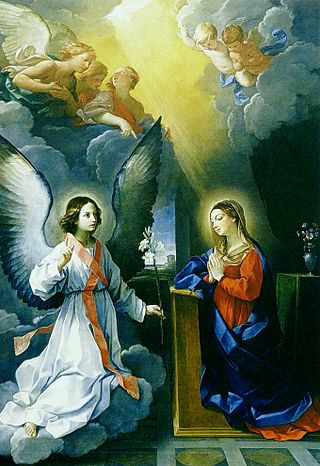
The Abduction of Helen is a 1628-1629 oil on canvas painting by Guido Reni, now in the Louvre Museum in Paris. [1]

The Abduction of Helen is a 1628-1629 oil on canvas painting by Guido Reni, now in the Louvre Museum in Paris. [1]
In 1627, via his ambassadors in Italy, Philip IV of Spain had ordered from Guido Reni a large canvas showing the rape of Helen of Troy. Like Reni, cardinal Bernardino Spada was then in Bologna, in his case as papal legate. This allowed him to follow the commission personally, especially since Philip's rank gave it political implications of interest to the papal court. Some art historians suggest that - in this Thirty Years War context - the pro-French pope Urban VIII even used the work to send a message to his arch-enemy on the Spanish throne. [2] Some have argued that it and Guercino's The Death of Dido were part of a joint allegory directed at Philip IV and Maria by the papal court.

After its completion Reni and the Spanish ambassadors fell out over his payment and the painting went unsold, with Spada taking the opportunity to suggest Maria de' Medici buy it instead. She accepted the suggestion and it thus set off for France. [2] When Abduction reached France but could not be collected by Maria (who had in the meantime fallen from power), it was instead acquired in or before 1654 by marquess Louis Phélypeaux de La Vrillière, who put it in his now-lost gallery in Paris and commissioned a pendant for it by Pietro da Cortona with the title Caesar Giving Cleopatra the Throne of Egypt. [2] It appeared in a posthumous inventory of his estate and was sold off by his grandson Louis III de La Vrillière (1672-1725) to Louis Raulin Rouillé, controller-general of the posts, whose widow in turn sold it in 1713 to Louis-Alexandre de Bourbon, comte de Toulouse (1678-1737), Louis XIV and Madame de Montespan's legitimised son. [1] It was inherited by the comte's son Louis de Bourbon, duc de Penthièvre (1725-1793) in 1737 and seized upon the French Revolution along with the rest of his collection. [1] Taken to the Louvre, it was first exhibited in the Musée Central des Arts in 1801 and was placed in the château de Maisons-Laffitte for safety during the First World War. [1]

The House of Bourbon is a dynasty that originated in the Kingdom of France as a branch of the Capetian dynasty, the royal House of France. Bourbon kings first ruled France and Navarre in the 16th century. A branch descended from the French Bourbons came to rule Spain in the 18th century and is the current Spanish royal family. Further branches, descended from the Spanish Bourbons, held thrones in Naples, Sicily, and Parma. Today, Spain and Luxembourg have monarchs of the House of Bourbon. The royal Bourbons originated in 1272, when Robert, the youngest son of King Louis IX of France, married the heiress of the lordship of Bourbon. The house continued for three centuries as a cadet branch, serving as nobles under the direct Capetian and Valois kings.

Marie de' Medici was Queen of France and Navarre as the second wife of King Henry IV. Marie served as regent of France between 1610 and 1617 during the minority of her son Louis XIII. Her mandate as regent legally expired in 1614, when her son reached the age of majority, but she refused to resign and continued as regent until she was removed by a coup in 1617.

Henri, Count of Chambord and Duke of Bordeaux was the Legitimist pretender to the throne of France as Henri V from 1844 until his death in 1883.

Elisabeth Farnese was Queen of Spain by marriage to King Philip V. She was the de facto ruler of Spain from 1714 until 1746 since she managed the affairs of state with the approval of her spouse, and is particularly known for her great influence over Spain's foreign policy. From 1759 until 1760, she governed as regent.

Guido Reni was an Italian painter of the Baroque period, although his works showed a classical manner, similar to Simon Vouet, Nicolas Poussin, and Philippe de Champaigne. He painted primarily religious works, but also mythological and allegorical subjects. Active in Rome, Naples, and his native Bologna, he became the dominant figure in the Bolognese School that emerged under the influence of the Carracci.

The Duchy of Parma and Piacenza was an Italian state created in 1545 and located in northern Italy, in the current region of Emilia-Romagna.

Mariana Victoria of Spain was an Infanta of Spain by birth and was later the Queen of Portugal as wife of King Joseph I. She acted as regent of Portugal in 1776–1777, during the last months of her husband's life and as advisor to her daughter, Maria I of Portugal, in her reign.

Louis Alexandre de Bourbon, a legitimated prince of the blood royal, was the son of Louis XIV and of his mistress Françoise-Athénaïs, marquise de Montespan. At the age of five, he became grand admiral of France.

Louis-Michel van Loo was a French painter.

The Palazzo Spada is a palace located on Piazza di Capo Ferro #13 in the rione Regola of Rome, Italy. Standing very close to the Palazzo Farnese, it has a garden facing towards the Tiber river.

René de Froulay, Count of Tessé was a French soldier and diplomat during the reign of Louis XIV and the 1715–1723 Regency.

A crown-cardinal was a cardinal protector of a Roman Catholic nation, nominated or funded by a Catholic monarch to serve as their representative within the College of Cardinals and, on occasion, to exercise the right claimed by some monarchs to veto a candidate for election to the papacy. More generally, the term may refer to any cardinal significant as a secular statesman or elevated at the request of a monarch.

The Hôtel de Toulouse, former Hôtel de La Vrillière is located at 1 rue de La Vrillière, in the 1st arrondissement of Paris. Originally, the mansion had a large garden with a formal parterre to the southwest.

Prince Francis of the Two Sicilies, Count of Trapani was a member of the House of Bourbon-Two Sicilies.

The Galleria Spada is a museum in Rome, which is housed in the Palazzo Spada on Piazza Capo di Ferro. The palazzo is also famous for its façade and for the forced perspective gallery by Francesco Borromini.

The Death of Dido is a 1631 oil-on-canvas painting by the Italian Baroque painter Guercino, commissioned by Cardinal Bernardino Spada for Maria de' Medici. It now hangs in the Galleria Spada in Rome.

Annunciation is an oil on canvas painting by Guido Reni, commissioned by Marie de' Medici and probably painted in early 1629. The first large painting by the artist to reach France, it is now Inventory Number 521 in the Louvre Museum, displayed on the first floor in Room 12 of the Grande Galerie. Reni also produced an earlier and less-worked-up version of the work in 1621 for the church of San Pietro in Valle, Fano which is now in that town's art gallery.

Hersilia Separating Romulus and Tatius or The Battle Between the Romans and the Sabines is a 1645 oil on canvas painting by Guercino, seized by the state during the French Revolution in 1794 and placed in the Louvre, where it still hangs. It shows Hersilia breaking up a battle between her husband Romulus and her Sabine brother Titus Tatius, with two other unnamed women doing similar in the background.

Caesar Restoring Cleopatra to the Throne of Egypt' is an oil on canvas painting by Pietro da Cortona, one of three works by this artist and six works by others commissioned by Louis Phélypeaux, Seigneur of La Vrillière for the gilded gallery at his new hôtel de La Vrillière in Paris - he requested that the nine works be in similar style and dimensions to Guido Reni's The Abduction of Helen (Louvre), the first painting he ever acquired. It is usually dated to 1637. It has been in the musée des Beaux-Arts de Lyon since 1811.